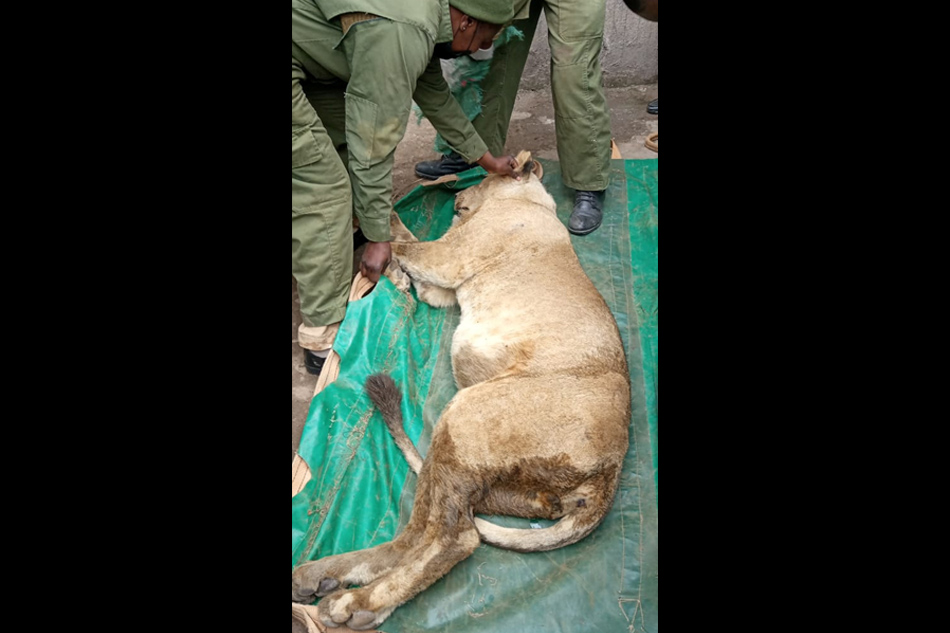No animal left behind: Kenya holds first national wildlife census | ABS-CBN
ADVERTISEMENT

Welcome, Kapamilya! We use cookies to improve your browsing experience. Continuing to use this site means you agree to our use of cookies. Tell me more!
Overseas
No animal left behind: Kenya holds first national wildlife census
No animal left behind: Kenya holds first national wildlife census
Hillary Orinde,
Agence France-Presse
Published Aug 05, 2021 02:49 PM PHT
ISIOLO— The flimsy planes tethered to metal drums to prevent them from accidentally becoming airborne is unlikely weapons in Kenya's fight to protect threatened species as it conducts its first national wildlife census.
ISIOLO— The flimsy planes tethered to metal drums to prevent them from accidentally becoming airborne is unlikely weapons in Kenya's fight to protect threatened species as it conducts its first national wildlife census.
Decades of unbridled poaching, expanding human settlements, and climate change have taken a heavy toll on the global wildlife population, and central Kenya is no exception.
Decades of unbridled poaching, expanding human settlements, and climate change have taken a heavy toll on the global wildlife population, and central Kenya is no exception.
African savanna elephants have been particularly hard-hit, with their numbers plunging by at least 60 percent during the last half-century, according to the International Union for Conservation of Nature (IUCN).
African savanna elephants have been particularly hard-hit, with their numbers plunging by at least 60 percent during the last half-century, according to the International Union for Conservation of Nature (IUCN).
So the pilots preparing their aircraft at the tiny airport at Isiolo know they are on the frontlines of a battle with far-reaching consequences.
So the pilots preparing their aircraft at the tiny airport at Isiolo know they are on the frontlines of a battle with far-reaching consequences.
ADVERTISEMENT
"Elephants are the key animals, but when you are able to locate (any) endangered species, you feel like the census is on the right track," pilot Chris Cheruiyot tells AFP as he fastens the safety belt of his passenger, Julius Kabete.
"Elephants are the key animals, but when you are able to locate (any) endangered species, you feel like the census is on the right track," pilot Chris Cheruiyot tells AFP as he fastens the safety belt of his passenger, Julius Kabete.
A camera and audio recorder dangling from his neck, Kabete will spend the next few hours counting Somali giraffes, Grevy's zebras, oryxes, and other animals as the pair cruise the windy skies and refuel their two-seater Aviat Husky aircraft at specially set up stations in the forest.
A camera and audio recorder dangling from his neck, Kabete will spend the next few hours counting Somali giraffes, Grevy's zebras, oryxes, and other animals as the pair cruise the windy skies and refuel their two-seater Aviat Husky aircraft at specially set up stations in the forest.
The ambitious exercise, which kicked off in May, covers major species in more than 50 of Kenya's national parks and reserves as well as private and community conservancies, and includes marine life.
The ambitious exercise, which kicked off in May, covers major species in more than 50 of Kenya's national parks and reserves as well as private and community conservancies, and includes marine life.
Much of the existing data on the country's wildlife population are gathered individually by local advocacy groups or international conservationists, contributing to a scattershot approach to animal protection.
Much of the existing data on the country's wildlife population are gathered individually by local advocacy groups or international conservationists, contributing to a scattershot approach to animal protection.
Furthermore, training spotters is often both time-consuming and expensive.
Furthermore, training spotters is often both time-consuming and expensive.
The result is that many scientists prefer to use models to map wildlife instead of tracking animals in the flesh, says zoologist Iain Douglas-Hamilton of Save the Elephants.
The result is that many scientists prefer to use models to map wildlife instead of tracking animals in the flesh, says zoologist Iain Douglas-Hamilton of Save the Elephants.
"They publish modeled results (rather) than raw data," he told AFP.
"They publish modeled results (rather) than raw data," he told AFP.
That makes this maiden census especially important. Its information will help the East African nation map a long-term strategy to save a cherished asset that is also a major tourist draw.
That makes this maiden census especially important. Its information will help the East African nation map a long-term strategy to save a cherished asset that is also a major tourist draw.
'Very worrying'
But numbers tell only half the story. For the rest, the spotters need to track the animals' habits— where they eat, drink and rest.
But numbers tell only half the story. For the rest, the spotters need to track the animals' habits— where they eat, drink and rest.
At a hotel in Isiolo, a team listens to audio files chronicling a day's work.
At a hotel in Isiolo, a team listens to audio files chronicling a day's work.
The preliminary data are already "very worrying," says Fred Omengo, a scientist with the Kenya Wildlife Service (KWS), explaining that many of the animals were spotted around watering holes close to people's homes, a sign of extensive human encroachment into wildlife territory.
The preliminary data are already "very worrying," says Fred Omengo, a scientist with the Kenya Wildlife Service (KWS), explaining that many of the animals were spotted around watering holes close to people's homes, a sign of extensive human encroachment into wildlife territory.
"The little (food) that is available is basically a competition between domestic and wild animals," he tells AFP.
"The little (food) that is available is basically a competition between domestic and wild animals," he tells AFP.
"In most cases, domestic animals will have an upper hand."
"In most cases, domestic animals will have an upper hand."
And, as humans attempt to fence out wildlife, both are paying a deadly price.
And, as humans attempt to fence out wildlife, both are paying a deadly price.
Nearly 500 people were mauled or crushed to death by wild animals between 2014 and 2017, the KWS said in a report published in December 2019. More recent figures were not available.
Nearly 500 people were mauled or crushed to death by wild animals between 2014 and 2017, the KWS said in a report published in December 2019. More recent figures were not available.
And the threat to humanity and to wildlife is only set to intensify, conservationists warn.
And the threat to humanity and to wildlife is only set to intensify, conservationists warn.
"All wildlife routes have been closed by humans and now elephants want water, know where it is but can't get there. This is a worry," Robert Obrein of KWS says.
"All wildlife routes have been closed by humans and now elephants want water, know where it is but can't get there. This is a worry," Robert Obrein of KWS says.
"We have encroached into areas we have never been (in) before, and the numbers are growing. That means in another 10 years, we might not be having wildlife outside protected areas."
"We have encroached into areas we have never been (in) before, and the numbers are growing. That means in another 10 years, we might not be having wildlife outside protected areas."
Wind and dust
It is a fear not lost on the census takers, whose patient, painstaking efforts are often cut short by poor weather.
It is a fear not lost on the census takers, whose patient, painstaking efforts are often cut short by poor weather.
As sharp gusts sent clouds of dust flying into the atmosphere, diminishing visibility to less than half a kilometer, the three pilots circled back for home after a 4-hour mission, accepting defeat for now.
As sharp gusts sent clouds of dust flying into the atmosphere, diminishing visibility to less than half a kilometer, the three pilots circled back for home after a 4-hour mission, accepting defeat for now.
The aircraft is "inherently unstable" and too light to tackle high winds, explained Kennedy Shamala.
The aircraft is "inherently unstable" and too light to tackle high winds, explained Kennedy Shamala.
"You are flying below 500 feet (150 meters) above ground level, so you have minimum altitude to play with," the soft-spoken pilot told AFP.
"You are flying below 500 feet (150 meters) above ground level, so you have minimum altitude to play with," the soft-spoken pilot told AFP.
"You are working throughout, both your legs and hands and observing."
"You are working throughout, both your legs and hands and observing."
FROM THE ARCHIVES:
ADVERTISEMENT
ADVERTISEMENT


